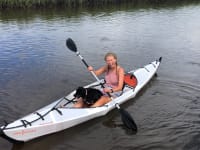Everything you need to start playing golf
All the gear you need to get started—and what you can skip
Products are chosen independently by our editors. Purchases made through our links may earn us a commission.
Golf seems like the perfect sport to play in these imperfect times. It’s outside in the fresh air, relatively easy on your muscles, and lets you be somewhat social while giving your foursome enough space to stay safely distant. There are many good reasons to take up the sport, especially this summer.
But what, exactly, do you need to have before you start playing? A quick Google search for golf equipment can send you down a rabbit hole trying to figure out which gear is essential, which is optional, and what doesn’t break the bank. We're here to help. I've played the sport for over 40 years and covered professional golf for ESPN and the Washington Post, so I know my way around the pro shop.
Let me let you in on a secret: If you're just getting started, forget the bells and whistles, just focus on decent tools to enjoy the afternoon out on the links. Here's what you need—and what you don't—to have a great time on the course.
A decent set of clubs, or at least the 5 basic ones
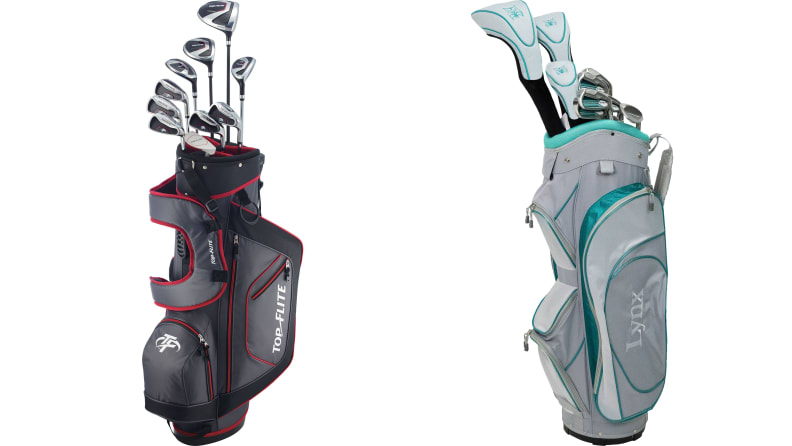
A great set of clubs can help you set the foundation for your golf game.
What you need to know: To state the obvious, clubs are one of two must-have items to tee it up. You can purchase them individually or as part of a set. To get started, you’ll need these basics: a putter, 5-iron, 7-iron, 9-iron, and driver. A decent starter set will provide you with between 9-13 clubs, which is plenty. (The max is 14, by the way.)
Bare minimum: You can mix and match equipment at various thrift shops and public course “used clubs” bins, which could run you as little as $10 per club. Avoid borrowing a friend’s rusty set that’s been in the basement for 20 years. You’ll look like you’re not taking this seriously at all, which might be true, but you don’t want to telegraph that.
One step up: If you are going to spend any extra money, focus on the putter and driver because you will use them most. Strata and TopFlight are two popular brands that will “only” cost you between $125-250 in most retail stores for a full set. Think of these clubs like that first car you bought. You didn’t get your drivers license and immediately buy that Porsche, did you?
Pro tip: Take a pass on the ball retriever. It sends the message that you spend too much time in the water hazard.
Two great options:
- Get the Men’s Top Flite 2020 XL 13-Piece Complete Set from Dick's Sporting Goods for $219.99
- Get the Women’s Lynx Power Tune Women's Complete 11-Piece Golf Club Set with Cart Bag from Walmart for $185.99
A decent set of golf balls
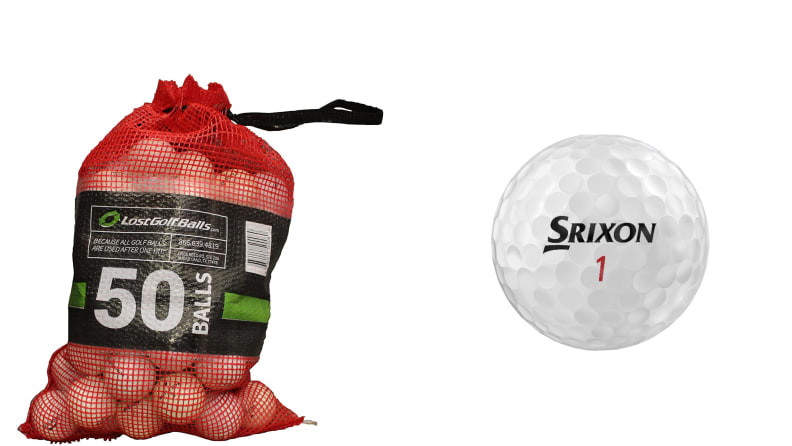
To play golf, you need a ball.
What you need to know: Golf balls are the other requirement. Unlike mini-golf or the driving range, golf courses will expect you to bring your own. While you can purchase them at the pro shop, you’ll pay through the nose.
Bare minimum: Used or "recycled" golf balls are cheap on Amazon, sometimes $.50 a ball. Remember, though, that someone probably fished them out of a pond.
One step up: The reality is that unless you are a scratch golfer, top-of-the-line Titleist or Callaway balls won’t make a difference. A brand-new dozen could run between $50-60. Instead, go for the more basic model that might not be endorsed by the majority of tour pros. Srixon or TaylorMade have brand recognition, and they're cheap enough so you won't be too upset if one gets lost in the woods.
Pro tip 1: Be careful when you see a too-good-to-be-true deal online. That almost-half-off deal could be for only half-a-dozen balls. And if you see a suspect site selling a dozen brand-name golf balls for 20 bucks, they might be used—or yellow.
Pro tip 2: Get a Sharpie and mark your ball with a symbol, like three dots. It will make you look like you’ve been here before.
Two great options:
- Get the TaylorMade Recycled Golf Balls Mix (Pack of 50) on Amazon for $24.99
- Get the Srixon 2019 Z-STAR XV Golf Balls (Pack of 12) at GolfGalaxy for $39.99
A decent golf bag to carry your equipment
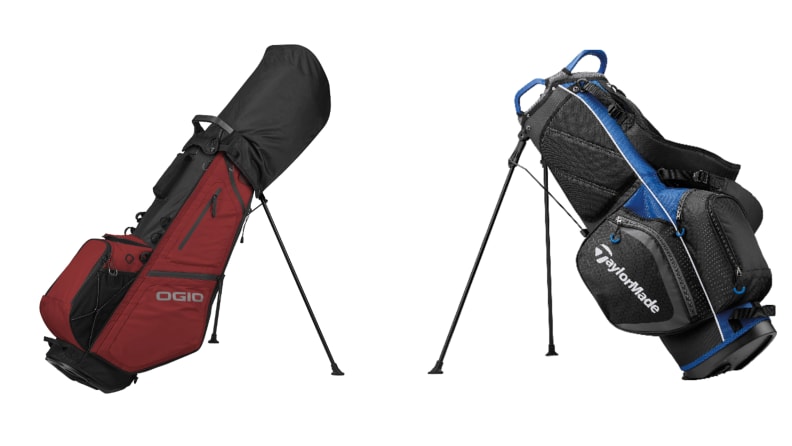
Carry the essentials in these roomy bags.
What you need to know: You’ll need something to carry around all of your equipment while you’re out on the course, and the duffle bag for your gym clothes isn’t going to cut it.
Bare minimum: A “Sunday Bag” could cost you less than $25, but you won’t be able to fit a full set of clubs. Amazon has plenty to offer, as does Dick Sporting Goods.
One step up: First off, if you are buying a starter set of clubs, it will likely come with a bag, so don’t double up here and add to your expenses. If you need a separate bag, make sure it has at least a double shoulder strap and a stand. Those two features alone will save your back in the long run. After that, the choice is basically between color, number of pockets, and most importantly, weight. PING and TaylorMade have a few on the cheaper side ($125-160) while Titleist and Ogio can be a bit pricier ($200-300.)
Pro tip: Avoid the tour bag. When you add clubs and balls to it, we’re talking 30-plus pounds easy. After the round, no one will be talking about what kind of bag you had. Your choice of driver, on the other hand, might come up.
Two great options:
- Get the OGIO Women's XIX 5 Stand Golf Bag at GolfGalaxy for $249.99
- Get the TaylorMade 2019 Select Stand Bag at GolfGalaxy for $159.99
A decent pull cart to save your back
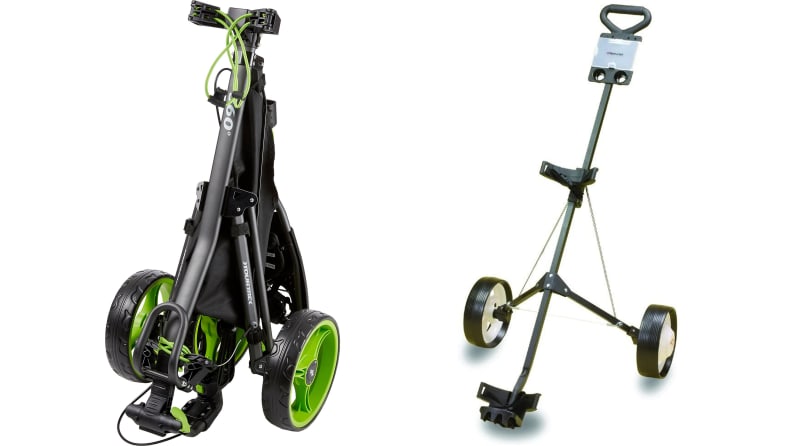
A pull cart helps you tote your bag and clubs around the course without too much effort.
What you need to know: Don't feel like carrying your bag the whole time? The right pull cart can save your day. But, just like a cart that you drive on the golf course, pull carts don’t belong in sand traps or on the green. Otherwise, they are fair game for the rest of the course.
Bare minimum: Search on Craigslist or Amazon in the used category and you’ll find plenty. A good cart can be had for less than $50, sometimes even $25. If you use it even just a couple of times, it pays for itself.
One step up: Think of pull carts like lawnmowers. You can purchase a used one for rock bottom prices, a push mower with some automation, or a souped up riding mower. Your basic model of pull carts range from approximately $75-400. A key buying tip: just like golf bags, the weight of a pull cart is crucial as you fold it up and wedge it into the trunk of your car.
Pro tip 1: The typical golf manufacturers don’t have the same market share as in other categories, so if you are searching for a name brand, you might not find it.
Pro tip 2: With the advent of social distancing, golf has become somewhat of an “in” sport, especially with contactless play. Thus, pull carts have become scarce. If you find one, snatch it up—fast.
Two great options:
- Get the JEF WORLD OF GOLF Deluxe Steel Push Cart on Amazon for $41.98
- Get the TourTrek 2018 360 3-Wheel Push Cart from Dick's Sporting Goods for $179.99
A rangefinder to keep you on track, no matter where the ball lands
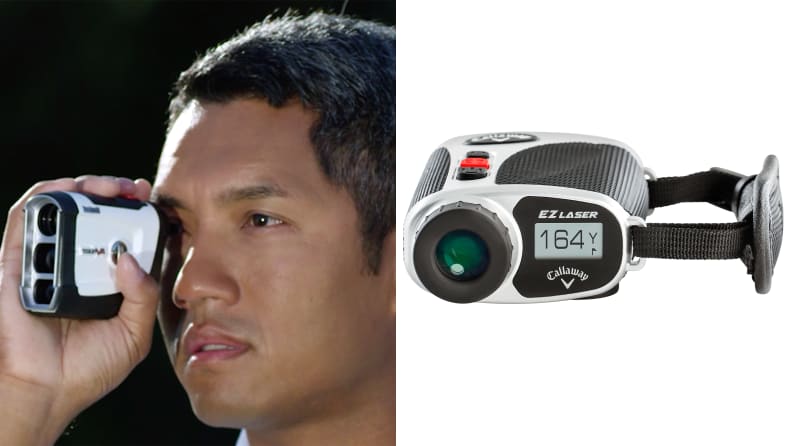
Scope out your distance from the hole with a rangefinder.
What you need to know: Sure, you know to use the driver when you’re teeing off or the putter on the green. But the other clubs? That’s where the rangefinder comes in. This device takes the guesswork out of calculating how far you are from the hole—whether you are in the fairway, rough, or sand trap.
Bare minimum: Some smart watches serve the same purpose for measuring distances on the course and they tend to cost less than traditional range fingers. The downside is that it is attached to your body, which is one more item to get in the way of your swing.
One step up: The “cheaper” ones are typically north of $200, so like many gadgets in golf, be prepared to spend some cash here. If you are lucky enough to find one on clearance, grab it, especially if it’s a Bushnell. Callaway’s rangefinders can be had for less, and they are still solid quality.
Pro tip: Figure out which end to aim and point with your rangefinder before you get to the course. Otherwise you might look like someone trying to fish with the wrong end of the rod.
Two great options:
- Get the Callaway EZ Laser Golf Rangefinder at Walmart for $199.99
- Get the Bushnell Tour v4 Patriot Pack Laser Rangefinder at Dick's Sporting Goods for $249.99
A golf shirt that will fit you—and fit in
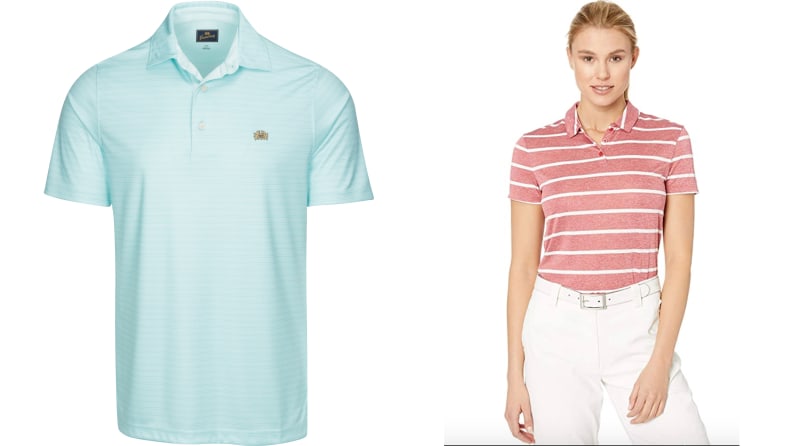
Keep up appearances on the course with these slick polos.
What you need to know: Dress code etiquette at most golf courses requires you to wear a shirt with a collar and no jeans. Just to be safe, though, you might want to check with your playing partners if the course has any unique rules for your attire—such as no shorts.
Bare minimum: Costco or BJ’s often have the best deals on this vital piece of equipment that can be worn beyond the course. They can be had for less than $20, but usually with no logos.
One step up: Peter Millar’s are beautiful, but if you’d like to avoid paying more for your shirt than your greens fees, focus on apparel that is cheaper. Nike Drifit or Adidas Climacool are breathable and the cost, between $50-75 usually, won’t crush your wallet. If you don’t mind non-traditional colors or patterns, you can find brand name golf shirts for less, but there is a reason no one else is buying those.
Pro tip: Do not wear a logo shirt of the course you are playing—unless that course is Pebble Beach.
Two great options:
- Get the Tourney Men's Short Sleeve Shadow Stripe Performance Golf Polo from Walmart starting from $18.95
- Get the Nike Women’s Drifit Dry Polo Stripe on Amazon starting at $27.42
Golf shoes—if you feel like you really need them
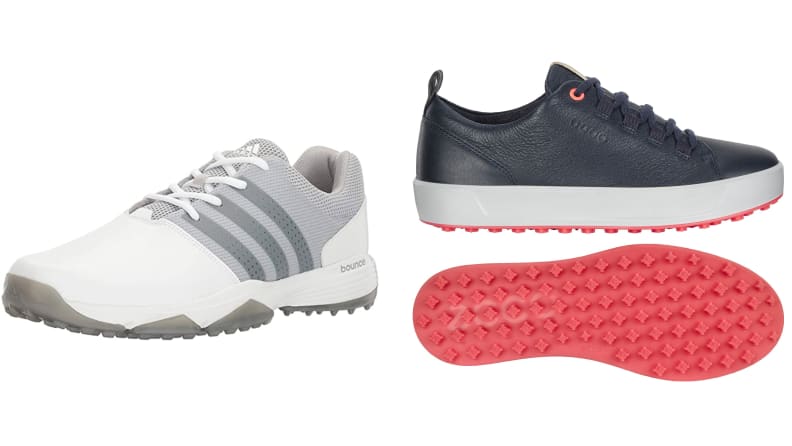
The right pair of kicks can escalate your golf game.
Bare minimum: Spending money on golf shoes is not necessary as long as the course isn’t wet or hilly. Sneakers will work just fine, but remember that more traditional golfers in your group might scoff at your footwear.
One step up: Golf spikes can significantly step up your attire. You can go old-school Foot-Joys, new-school Eccos, or something in between. A pair of Adidas could run you $50 on Amazon or you could drop a couple of hundred bucks on Under-Armour Gore-tex water proof kicks. Selecting golf shoes is a more personal choice. Do you prefer the traditional saddle shoe look or the pseudo-sneaker appearance? Those are the questions you have to ask yourself.
Pro tip: If you buy online, check ahead to see if the store has an easy return policy. Then, if you're unsure of your size, you can buy several pairs and return the ones that don't fit perfectly.
Two great options:
- Get the ECCO Women's Soft Golf Shoe from GolfGalaxy for $159.99
- Get the adidas Men's 360 Traxion from Amazon starting at $49.99
A hat for those sunny fairway days
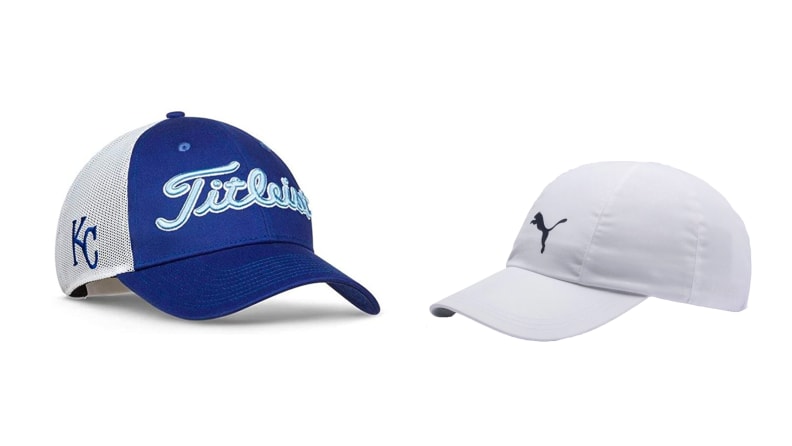
Keep the sun out of your eyes with a cap.
Bare minimum: Any old hat that you can find will work to keep the sun off your face, but remember that the logo and condition of your lid will be one of the first things people will notice.
One step up: Most pro shops sell a generic golf hat for about $25 in case you left yours at home. A nice bonus is to find one with the logo of a sports team in your part of the country, which Titleist often produces.
Pro tip: Not everyone can pull off a bucket hat. If you are wondering if you can, then you probably can’t.
Two great options:
- Get the PUMA Women's DuoCELL Golf Hat from GolfGalaxy for $22
- Get the Titleist New MLB MESH Golf Cap Royals Adjustable from Amazon for $24.99
Gear for the kids to join in the fun
What you need to know: Golf can be something you play with the whole family. Here's what your kids will need to get started.
Clubs: These are dependent on your child’s height and typically fall between $100-200 for a set, which might contain as few as six clubs. (Walmart has a decent set available for $133.) At this stage, you don’t want to overspend when they are still learning the sport. As they grow, though, expect to get new clubs in the same vein as purchasing a new bike when the old one doesn’t “fit” anymore.
Golf balls: Used golf balls are not the worst idea, but if you decide to go with new ones, many kids love the soccer ball version, available at Amazon for $39.99.
Kids clothes: Outfits can get pricey, so finding multi-use ensembles can help amortize the cost. This sleeveless dress and short combination from Amazon is great for golf, tennis, or playing in the backyard. Polo shirts (like this one available at Amazon) add a dressy collar to any wardrobe, and are far more comfortable than a fussy button-down.
Shoes: Don't bother. The way kids’ feet grow so quickly, sticking with sneakers or running shoes is the way to go until they tell you how much they love going to the course.


